Genealogist Lynn Serafinn discusses the origins of the Rigos family of Malosco in Val di Non, and how it evolved into two distinct branches, one of which is now extinct.
This article is also available as a 16-page downloadable, printable PDF, complete with clickable table of contents, colour images, charts, footnotes and resource list. Price: $1.50 USD.
Available in Letter size or A4 size.
CLICK HERE to buy this article in the ‘Digital Shop’, where you can also browse for other genealogy articles.
Image: Composite of various stemmi (coats-of-arms) of the noble Rigos of Malosco.[1]
INTRODUCTION
Premise
One of my life’s passions is the research of Trentino surnames. Occasionally, I am drawn to dive more deeply into the history of a particular surname than others. Very often, I become curious because the original family bearing that surname came to Trentino from outside the province. Other times, a surname appears in many different parts of the province, and I am curious to discover whether or not these disparate lines are ancestrally connected.
But the surname we will examine in this article meets neither of these criteria. Today, we look at the surname RIGOS, which is found almost exclusively in a single village: Malosco in Val di Non. Although ‘family lore’ claims the Rigos came from a foreign land, much evidence points to it being ‘home grown’, and that it was probably ‘born’ in the same place it has existed for at least the past half-millennium. Moreover, the surname has remained remarkably ‘static’ in that there do not seem to have been any significant migrations outside Malosco (at least not before the wave of migrations that started at the end of the 19th century).
I will often also become curious about a particular family if I know they were nobility. This curiosity does not stem from a particular fascination with nobility itself, but rather from the fact that noble families will often have a more definable ‘paper trail’ than non-nobility, as the diplomas that contain the details of their awards are often still extant. As we shall see, one of the Rigos lines was indeed ennobled, and the information we can glean from documents relating to their nobility can help us to piece together a narrative about them that cannot be gleaned from the parish registers alone.
Finally, I always become curious when an author says a particular family ‘went extinct’. It is true that one specific line of the Rigos family did die out before the end of the 18th century, and I will show precisely when this happened in this article. However, the Rigos of Malosco still exist via other lines not always mentioned in books, and I wish to illustrate this point, as some texts might lead readers to believe the surname no longer exists.
This article is not intended to be a complete genealogical review of the Rigos of Malosco, but an overview of their earliest appearance in available documents, and a summary of the destinies of its two primary lines. I have drawn my information from a combination of the parish registers for both Malosco and Sarnonico, along with transcriptions of legal parchments, and research compiled by previous historians.
All the books and documents I consulted are in either Italian or Latin. All translations are my own.
IMPORTANT NOTE: ‘RIGOS’ is NOT the same surname as ‘RIGO’, which is found in many other parts of Trentino, especially in Valsugana and in/around Rovereto.[2] While these two surnames probably have a similar linguistic root, the families bearing these surnames are neither historically nor genealogically connected.
Researching Malosco Families
Malosco has an ancient and colourful history. Most famously, it is the site of a medieval castle (and a noble family) that bore the same name. We also we know its church of Santa Tecla was already established 800 years ago via the Last Will and Testament, dated 18 August 1228, of Pietro, a Lord of Malosco, who requested that a gift of oil would be given to that church every year on his behalf. [3]
Despite its antiquity, the church of Santa Tecla has been an independent parish for only a bit more than century, having been elevated parish status on 1 August 1919.[4] Before then, it was considered a curate (a ‘daughter’ parish) of the larger parish of Sarnonico. It is important to know this when tracing the histories of the families of Malosco, because you will most likely be working with the parish records for Sarnonico for most of your research.
Where to Look for Malosco Births, Marriages and Deaths
- Malosco started recording its own BAPTISMAL records in 1768, even though it was still considered a curate. However, between 1768 and the early 20th century, you are likely to find many Malosco baptisms recorded in both Malosco and Sarnonico. Occasionally you will find a record in one or the other, so it’s always a good idea to check both places. ALL Malosco baptisms before 1768 will be found ONLY in the Sarnonico registers.
- ALL Malosco MARRIAGE records before the year 1919 will be found in the Sarnonico registers.
- ALL Malosco DEATH records before the year 1917 will be found in the Sarnonico registers.
Overview of Sarnonico Parish Records
Sarnonico is one of the most ancient parishes of Val di Non; it is comprised of a matrix of curate churches in Cavareno, Malosco, Ruffré, Ronzone, Seio and Vasio, as well as its own parish church.
The BAPTISMAL records for Sarnonico go back to the year 1585, but be aware:
- The names of the mothers are often omitted in the early baptismal records. Thus, when there happen to be two men of the same name in the same era, it can often be difficult to know which child belongs to whom, unless the record happens to mention the name of the paternal grandfather. Even in the index (compiled long after the records were written), you will find instances where the priest wrote question marks after some entries, as he was unsure who was who.
- There is a GAP in the baptismal records from July 1609 to January 1616. Thus, you will often find evidence of adults whose birth records ‘should’ be in the register, but they are not. I also suspect other records are missing besides those within this timeframe.
- There are two random pages of baptisms from 1628-1629 mixed in with the marriages in the 1620s. They are not duplicates, and they do not appear in the baptismal register.
- Volumes 3 (1629-1650) and 4 (1650-1681) of baptismal records are organised in alphabetical order according to FIRST name. As such, they tend to leap around chronologically, and sometimes you will find things entered in the wrong place.
The MARRIAGE records for Sarnonico date back to the year 1586, however:
- Volumes 1 and 2 of the marriage records contain indices, but the priest who made the index for volume 1 has also written that he was unable to understand a great many of names, and he did not record them. Hence, in my estimation, about a quarter of the records in volume 1 are omitted from the index.
- Many pages referred to in the marriage indices are missing. Volume 1 of the marriage register contains only pages 41-52 and 61-64 of the original register. Volume 2 starts on page 58; pages 63-64 are missing. I am unsure at this point whether they are actually missing, or if they were never microfilmed/digitised.
- The beginning of volume 1 is extremely disorganised. There is ONE record from 1586, then it leaps ahead to 1619, then back to 1587. After 1589, it stops and jumps to 1601, moving forward from that point, meaning there is about an 11-year gap here. Many records are extremely hard to read, as they tend to run into each other.
- The dates at the beginning of volume 2 of the marriage records also leap around.
- MY SUMMARY OF GAPS IN SARNONICO MARRIAGE RECORDS: Dec 1589-Dec 1600; Nov 1612-Feb 1618; Dec 1619-March 1627; Aug 1638-Jan 1655.
The DEATH records for Sarnonico begin in the year 1664. While I have not yet found any significant gaps in the death records, the main issue is that the earlier registers do not appear to include infant/child deaths.
Where to View the Records
All of the parish records for Trentino have been digitised by the Archivio Diocesano di Trento, and they are viewable at their research centre in the city of Trento. If you know what you need, you can also obtain copies via email. They cannot do extensive research for you.
The LDS church microfilmed these registers back in the 1980s, but most of their Family History Centres no longer have microfilm readers, as they gradually work on digitising all their films. Digital images are only viewable at their Family History Centres; they and are not available online. As of this writing, the films for Sarnonico and Malosco have not yet been digitised by the LDS, but you should check with them to see if this has since changed.
If you are unable to access the records for these parishes via the means above, you are welcome to contact me via https://trentinogenealogy.com/contact, as my professional research over the years has enabled me to obtain all the records for both parishes.
PART 1: Overview of the Surname ‘Rigos’
Geographic and Linguistic Origins
Traditionally, Rigos ‘family lore’ maintains that they originally came from Spain,[5] [6] and that surname is a patronymic derived from the name ‘Enrique’, equivalent of the present-day Italian name ‘Enrico’ and the English name ‘Henry’. Perhaps the strongest linguistic argument for this claim is that the surname ends in ‘-os’, which is a common suffix in Spanish names and surnames, and one that is not generally seen in names of Italian origin.
Most historians, however, disregard this theory, saying that ‘Rigos’ is derived from the Germanic personal name ‘Rigo’ (a diminutive form of the name ‘Hendrigus’ or ‘Henrico’),[7] [8] which was a reasonably popular name in medieval Trentino. Linguistic historian Aldo Bertoluzza also suggests it could have been derived from another medieval name, i.e., ‘Arrigo’,[9] which he says means ‘extremely wealthy’[10]. He also theorises that it might be a diminutive of the Trentino name ‘Odorico’ or ‘Udalrico’, which itself is a derivation of the Old German name ‘Od-Rik’.[11] Strictly from an historical perceptive, Germanic origins seem more plausible than Spanish, given Trentino’s proximity to German-speaking South Tyrol (AKA the province of Bolzano) and its ancient historical connection with Tirolean Austria. There are also many surnames of Germanic origin in the province.
One thing we know with certainly is that a good half-dozen Rigos households appear in the first volume of Sarnonico baptismal records starting in 1585, with at least 17 Rigos children baptised in the 25-year span from 1585 through 1609. We also know by inference in later records that there were several others born in the 8-year gap in the register between 1609-1616. Occasionally in these early records, we find references to paternal grandfathers, which helps us extend our research by an additional generation.
Using the parish register alone, I have identified at least 10 different Rigos households whose patriarchs would have been born roughly between 1520-1560. The eldest of these were Giovanni and Nicolò, both of whom were probably born around 1520-1525. I know each of these men had at least one son, and I suspect Nicolò may have had at least two sons. The five remaining Rigos patriarchs may well have been related in some way, but whether they were sons, brothers or cousins, I cannot say at this point.
Whenever we see this many households bearing a surname in a small, rural village, it is usually a good indication that the family had already been well-established in that place for many generations. Knowing this, I feel confident in theorising that the Rigos had already been living in Malosco when surnames were first ‘invented’, which was normally around the early to mid-1400s. I feel this makes a strong case against the idea of Spanish origins, as it seems likely the surname was ‘born’ in Malosco.
But whatever the case, if the surname is indeed a patronymic, we currently have no trace evidence of the specific patriarch named ‘Rigo’ or otherwise, from whose name the surname was derived.[12]
Variant Spellings in Early Records
You will find many variant spellings for the surname Rigos in the 1500s and into the early 1600s.
Some authors tell us that the surname was recorded as ‘Righi’ in many documents through the early 1500s,[13] [14] although I have not yet personally seen this version.
In his book of on notaries, priest-historian P. Remo Stenico lists a ‘Cristoforo, son of Ser Nicolò Rigossi of Malosco,’ a notary whose name appears in a document from 1579, [15] which is surely a variant of Rigos. It is significant that Nicolò is referred to as ‘Ser’, which generally indicates some form of nobility.
The variant I have seen most frequently is ‘Rigousi’, sometimes with Latin declensions ‘-is’ or ‘-us’. Below is the baptismal record, dated 26 June 1601, for Maddalena, daughter of Pietro Rigos (spelled ‘Rigousis’) and his wife Maria.[16] Notice that the godfather is another Rigos, i.e., Giacomo, son of Tommaso Rigos (‘Jacobus, filius Tomei de Rigousis’). Notice also that someone (most likely the priest who made the index for the register) has written the name ‘Rigos’ above the surname, to clarify what ‘Rigousis’ means.
Click on image to see it larger
Although these variants appear into the early 1600s, for the most part the surname was already recognised as ‘Rigos’ by the time the Sarnonico baptismal register begins in 1585. The earliest record showing this is dated 6 March 1586, for the baptism of Lucia, daughter of Tommaso Rigos, son of the late Giovanni (the priest does not record her mother’s name).[17]
Click on image to see it larger
Two Overall Lines
When looking at the Rigos of Malosco, we notice there are basically two overall lines:
one that was ennobled, and one that was not.
The distinction between these two isn’t so apparent in the early parish records, because (for whatever reason) the status of the ‘noble line’ is rarely mentioned in the register until the mid-1700s, despite the fact they had already been ennobled for more than a century.
I find it interesting that, while each of these lines had many branches, I have found no instance of the two lines intersecting at any point in recorded history. This includes backwards as well as forwards in time. In other words:
- I have not yet found any instance in which a ‘noble’ Rigos married someone from the ‘non-noble’ Rigos line.
- I have not yet found any ancestral connection between the two lines.
That said, considering the localised nature of this surname, I would imagine the two lines were probably descended from the same patriarch at some point in antiquity. Unfortunately, we have no written documentation to prove or disprove this, and we are unlikely to be able to prove this through Y-DNA testing, as the male lineage of the ‘noble’ line died out more than two centuries ago.
Evolution, Expansion and Extinction
Some authors say the Rigos of Malosco are now extinct, but these writers are referring specifically to the noble ‘Rigos de Rigasburg’ line, and not the Rigos families as a whole. The surname is actually still very much alive.
Looking at the 19th century and later, the Nati in Trentino website shows us that 158 children with this surname were baptised in Trentino between the years 1815-1923.[18] Although the database shows a handful of births in other parishes (Condino, Arco, Cles, and Fondo), in every case I have been able to trace these families back to Malosco. The family of the Rigos child born in Fondo (Francesco Rigos, born 1 January 1851 and died in infancy[19]) even moved back to Malosco after his birth, where seven younger siblings were born.
Having now traced all of these lines, and I can confirm that NONE of these 19th century Rigos are descendants of the ‘noble line’. That line, as we will discuss next, did indeed die out before the end of the 1700s. Thus, if you have the surname Rigos, or if your most recent Rigos ancestor was born after the year 1784, you are definitely descended from one of the ‘non-noble’ Rigos lines.
Article continued below…
This article is also available as a 16-page downloadable, printable PDF, complete with clickable table of contents, colour images, charts, footnotes and resource list. Price: $1.50 USD.
Available in Letter size or A4 size.
CLICK HERE to buy this article in the ‘Digital Shop’, where you can also browse for other genealogy articles.
PART 2: The Noble Rigos of Malosco
Early Stemma (Coat-of-Arms)
In 1576, a Giacomo Rigos of Malosco (also written ‘Jacopo’), member of the Archducal Imperial Guard, was granted the right to use a stemma. [20] [21] This privilege was extended to Giacomo’s brother and cousins. The fact this privilege was not also extended to Giacomo’s son(s) would indicate either that he had no living male heirs, or that they were all of minority age at this time. I have not yet found any evidence he had any children.
Sadly, I have not found the names of said brother and cousins in any of the sources I have consulted. But after tracing the lines that were ennobled later and tracing them backwards, I suspect his brother may have been the father of Romedio Rigos (meaning Romedio would have been the nephew of Giacomo), who was the patriarch of the line that would later be granted imperial nobility in the 1600s.[22]
Their ancient stemma has a silver shield, and a picture of an upright green serpent, wearing a gold crown.[23] [24]
SIDE NOTE: Apparently, there is a house in Malosco on which you will find the Rigos stemma with a date of 1562,[25] [26] but this date may be for the Vasio family, whose stemma is pictured along with it.
Despite being granted a stemma, the family is not usually referred to as ‘noble’ in the parish records.
Imperial Nobility and Predicate
VARIANTS: Rigos de Rigasburg; Rigos von Rigosburg um Malusk; Rigos von Rigasburg und Malosco; de Rigaspergg.
Two generations later, we find the Rigos had increased significantly in social status. On 10 June 1634, Ferdinando II, Emperor of the Holy Roman Empire, granted Imperial nobility to Romedio Rigos, ‘Maggiordomo’ (Manager of the household) for Claudia de Medici, and his cousin Giacomo Rigos, Court Chamberlain.[27] [28]
With this diploma, the family were granted the use of the predicate ‘Rigos von Rigasburg und Malosco,’[29] although there are several variant spellings. The ones I see most frequently in the parish records is Rigos ‘de Rigasburg’ or ‘de Rigaspergg.’
With this title, the original serpent on their stemma was replaced by a lizard; in some versions, the lizard is flanked by two gold stars. Over time, other enhancements were added.[30]
Challenges of Identification
Although we have dates and names about these noble titles, identifying the specific Rigos men to whom these titles were granted has proved to be somewhat challenging.
So far, I have not been able to pinpoint precisely who Romedio and Giacomo were. The wording of the 1634 document infers that Romedio was the elder of the two cousins. He is probably the Romedio I mentioned earlier, whom I believe may have been the nephew of Giacomo who had been granted the stemma in 1576. Although he would surely have been in his late 70s by this point, the strongest evidence to support this theory is the fact that we can trace later noble lines back to him. Also, the only other males I have found with the name Romedio Rigos were still minors in 1634.
As to Giacomo, the only mention of a Giacomo in this era is in the baptismal record I shared earlier, in which Giacomo, son of Tommaso Rigos (written ‘Rigousis’) appears as a godfather.[31] We can surely exclude the Giacomo who had been granted the stemma in 1576, as he would have been about a century old by 1634; even if had still been alive, he was definitely older than Romedio.
Confirmation of Titles
On 15 May 1666, confirmation of the family’s noble titles, along with enhancements of the stemma, was granted by Emperor Leopoldo I to yet another Romedio Rigos, Chamberlain of Ferdinando III and resident Count Palatino in Graz, Austria. I am fairly certain this Romedio was the son of Nicolò, and the grandson of the Romedio who had been granted the Imperial title in 1634. If my configuration is correct, this Romedio was born in Malosco on 21 October 1622.[32]
This title was again reconfirmed by Prince-Bishop Antonio Thun on 18 May 1743 to Simone Antonio Rigos.[33] Born 19 December 1693,[34] he was the grandson of the abovementioned Romedio (born 1622), and the great-great-grandson of the Romedio who had been first granted the Imperial title.
Click on image to see it larger
We see in the baptismal record that Simone Antonio’s father was Pietro Paolo Rigos. Sometimes referred to as ‘Paolo’, Pietro Paolo was the son of the Romedio Rigos (born 1622) who had been Chamberlain of Ferdinando III and resident Count Palatino in Graz. As Pietro Paolo’s baptismal record is not in the Sarnonico register, I can only assume he was born in Austria. I suspect other Rigos children were not registers in Sarnonico for the same reason. Both Pietro Paolo and his son Simone Antonio lived long lives, reaching about 80 years of age.[35]
Overview of First Five Generations of Imperial Noble Line
Piecing together all of the information about the noble line, we can construct the following pedigree chart for Simone Antonio, back to his great-great-grandfather Romedio who had received the Imperial title in 1634.[36]
Click on image to see it larger
Looking at the naming pattern, it is possible that the Nicolò ‘Rigossi’, father of the notary Cristoforo (whom I mentioned earlier) was also the father of the elder Romedio. If so, this elder Nicolò would surely have been the brother of the Giacomo who had received the stemma in 1576. However, I am not yet confident enough to make this connection, so I have not included him in this chart.
Extinction of the Noble Line
Simone Antonio (born 1693) had at least 8 children with his wife Anna Rosina. Of these, most were girls, and I have only found evidence that one of sons – another Simone Antonio – reached adulthood and had children of his own.
That younger Simone Antonio was born in Malosco on 23 June 1741.[37] His baptismal record mentions a dizzying array of noble godparents.
Simone Antonio married the noble Elena Francesca Ferrari of Denno; the couple had four daughters and two sons between 1768-1783, but both of sons died in early childhood.
Simone Antonio himself died at the age of 41 on 19 April 1783,[38] one month before the birth of his last daughter, Anna Maria Francesca; you can see he is cited as deceased in her baptismal record, as indicated by the word ‘quondam’ (abbreviated as ‘qm’).[39]
Thus, having no sons to carry on the surname or title, with Simone’s Antonio’s death, we see the extinction of the noble Rigos line.
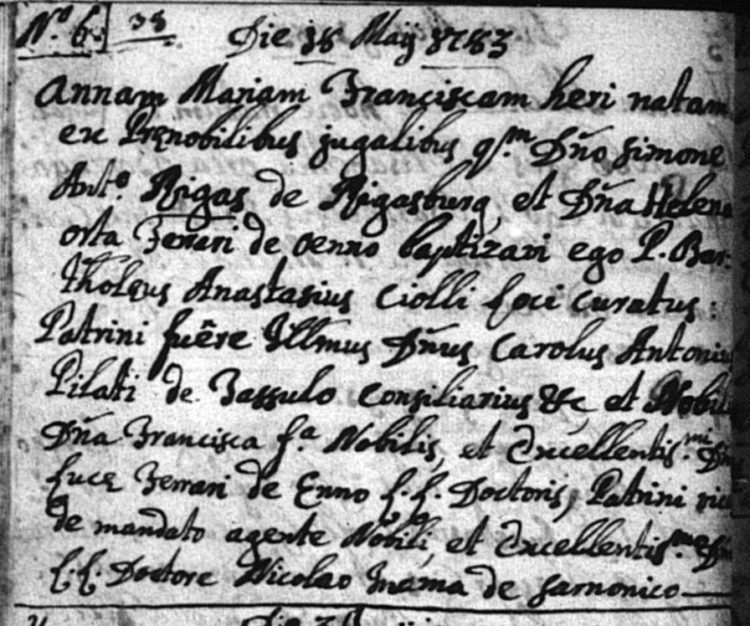 Click on image to see it larger
Click on image to see it larger
Continuation of ‘Gene Pool’ via Female Lines
If you look closely at the baptismal record for Simone Antonio’s posthumously born daughter Anna Maria Francesca, you will notice the godfather was the noble Carlo Antonio Pilati of Tassulo. Carlo Antonio was actually Simone Antonio’s brother-in-law, as he married Simone’s sister Maria Cattarina Francesca Rigos.
The marriage took place in Malosco on 20 January 1755. The record tells us that Maria Cattarina Rigos ‘de Rigaspergg’ of Malosco, daughter of (the elder) Simone Antonio, married the noble Carlo Antonio Pilati, son of Doctor Giovanni Nicolò Pilati of Tassullo.[40] The marriage record contains many honourifics, such as ‘Illustris’ (the most illustrious/distinguished), and ‘Excellentissimus’ (the most excellent), which are reserved for persons of Imperial noble rank.
Click on image to see it larger
I know at least one living person who is direct male descendant of this couple; but, of course, that person is not a ‘Rigos’ but a Pilati. Still, I show this record to illustrate that although the noble Rigos line has gone ‘extinct’ in terms of the male lineage, their genes live on through the descendants of some of their daughters.
Conclusions and Closing Thoughts
The aim of this article was to give a general overview of the origin and evolution of the Rigos families of Malosco. To conclude, I would like to summarise the key points I feel we can draw from our discussion:
- Although similar linguistically, the surname ‘Rigos’ has no historical connection to the surname ‘Rigo’, which appears in other parts of the province of Trentino.
- In Trentino, the surname ‘Rigos’ is unique to Malosco, where it has existed at least since the early 1500s, and probably at least a century earlier.
- Although local lore maintains the Rigos family came from Spain, there does not currently seem to be any evidence to support this; rather, the surname seems to have been ‘born’ in Malosco, with possibly Germanic linguistic origins.
- There are two primary Rigos branches: one ennobled, one not ennobled.
- These two branches do not appear to have intermarried at any point.
- These two branches are likely to be ancestrally connected, but I have not yet found any evidence to verify that connection.
- The male line of the ennobled branch, who used the predicate ‘de Rigasburg’, is now extinct; however, there are still living descendants via their daughters.
- The non-ennobled Rigos line is still thriving in Malosco, and some branches have moved out of Malosco since the beginning of the 20th
- If you have the surname Rigos, and your ancestors came from Malosco, you are descended from the non-noble line.
I hope you found this article to be informative and interesting. If you know of any information you feel should be added to this research, or if you have Rigos ancestors (or any other Trentino surnames) and would like to explore your family history, please do not hesitate to contact me at https://trentinogenealogy.com/contact.
This article and others on this blog are ‘working drafts’ of research for my ‘in progress’ book entitled Guide to Trentino Surnames for Genealogists and Family Historians, as well as another book I am writing that is comprised of longer studies of specific families, such as this article you have just read. That will still take me a couple of years to complete, but I already have a lot of material written for it. My aim will be to create a book of ‘case studies’ of origin and migration stories, which collectively can show us a bigger picture of the diversity of families who make up our beautiful ancestral province. I haven’t made up a working title for it yet, but I will surely let you know when I have.
In the meantime, if you enjoyed this article, you can help support my research by purchasing it as a 16-page downloadable, printable PDF, complete with clickable table of contents, colour images, charts, footnotes and resource list. Price: $1.50 USD.
CLICK HERE to buy this article in the ‘Digital Shop’, where you can also browse for other genealogy articles.
Until next time!

Warm wishes,
Lynn Serafinn
3 May 2022
P.S. I am currently taking client bookings for July 2022 and beyond. If you would like to book a time to discuss having me do research for you, I invite you to read my ‘Genealogy Services’ page, and then drop me a line using the Contact form on this site. Then, we can set up a free 30-minute chat to discuss your project.
Join our Trentino Genealogy Group on Facebook: http://facebook.com/groups/TrentinoGenealogy
Lynn on Twitter: http://twitter.com/LynnSerafinn
View my Santa Croce del Bleggio Family Tree on Ancestry:
https://trentinogenealogy.com/my-tree/
NOTES
[1] TABARELLI DE FATIS, Gianmaria; BORRELLI, Luciano. 2005. Stemmi e Notizie di Famiglie Trentine. Trento: Società di Studi Trentini di Scienze Storiche, page 369.
[2] I have not yet researched the surname Rigo extensively, but I do know it was present in Trambileno (near Rovereto) at least back to the first half of the 1600s, with no indication the family had come from elsewhere.
[3] WEBER, Simone (Sac.). 1992. Le Chiese delle Val di Non Nella Storia e Nell’Arte. Volume II: I Decanati di Cles e di Fondo. Mori (Trento): La Grafica Anastatica, page 166.
[4] CASETTI, Albino (dottore). 1951. Guida Storico – Archivistica del Trento. Trento: Tipografia Editrice Temi (S.R.L.)., page 432.
[5] MARINI, Pacifico. 2004. Malosco e la Sua Gente. Storia, ricordi, immagini di vita. Malosco: Comune di Malosco, page 64.
[6] AUSSERER, Carl. 1985. Le Famiglie Nobili Nelle Valli del Noce: Rapporti con i Vescovi e con i Principi Castelli, rocche e residenze nobili Organizzazione, privilegi, diritti; I Nobili rural. Translated by Giulia Anzilotti Mastrelli from the original German work Der Adel des Nonsberges, published in 1899. Malé: Centro Studi per la Val di Sole, page 118. Ausserer actually says ‘They used to pretend they were from Spain.’
[7] AUSSERER, Carl. Le Famiglie Nobili Nelle Valli del Noce (Der Adel des Nonsberges), page 118.
[8] MARINI, Pacifico. Malosco e la Sua Gente, page 64.
[9] AUSSERER, Carl. Le Famiglie Nobili Nelle Valli del Noce (Der Adel des Nonsberges), page 118.
[10] BERTOLUZZA, Aldo. 1998. Guida ai Cognomi del Trentino. Trento: Società Iniziative Editoriali (S.R.L.), page 295.
[11] BERTOLUZZA, Aldo. Guida ai Cognomi del Trentino, page 295.
[12] MARINI, Pacifico. Malosco e la Sua Gente, page 64.
[13] TABARELLI DE FATIS, Gianmaria; BORRELLI, Luciano. Stemmi e Notizie di Famiglie Trentine, page 240-241.
[14] MARINI, Pacifico. Malosco e la Sua Gente, page 64.
[15] STENICO, P. Remo. 1999. Notai Che Operarono Nel Trentino dall’Anno 845. Trento: Biblioteca San Bernardino, page 291.
[16] Sarnonico parish records, baptisms, volume 1, page 138-139.
[17] Sarnonico parish records, baptisms, volume 1, page 5.
[18] NATI IN TRENTINO. Provincia autonomia di Trento. Database of baptisms registered within the parishes of the Archdiocese of Trento between the years 1815-1923. https://www.natitrentino.mondotrentino.net/ .
[19] Francesco died 31 August 1851. Sarnonico parish records, deaths, volume 5, page 100-111. A later brother named Francesco Costantino also died in infancy.
[20] TABARELLI DE FATIS, Gianmaria; BORRELLI, Luciano. Stemmi e Notizie di Famiglie Trentine, page 240-241.
[21] AUSSERER, Carl. Le Famiglie Nobili Nelle Valli del Noce (Der Adel des Nonsberges), page 118.
[22] Romedio (likely born around 1550), may have been the son of the aforementioned Nicolò. I based this theory this solely on the fact that he had a son named Nicolò, who was born shortly before the beginning of the parish register.
[23] Black and white image from AUSSERER, Carl. Le Famiglie Nobili Nelle Valli del Noce (Der Adel des Nonsberges), page 118.
[24] TABARELLI DE FATIS, Gianmaria; BORRELLI, Luciano. Stemmi e Notizie di Famiglie Trentine, page 240-241.
[25] AUSSERER, Carl. Le Famiglie Nobili Nelle Valli del Noce (Der Adel des Nonsberges), page 121 (notes).
[26] MARINI, Pacifico. Malosco e la Sua Gente, page 64.
[27] TABARELLI DE FATIS, Gianmaria; BORRELLI, Luciano. Stemmi e Notizie di Famiglie Trentine, page 240-241.
[28] A Chamberlain is a person who manages and administers the goods and finances of a community. It usually refers to a role in the papal household, but the authors have used the word ‘di corte’ indicating he was employed by the royal household, not the pope.
[29] AUSSERER, Carl. Le Famiglie Nobili Nelle Valli del Noce (Der Adel des Nonsberges), page 118.
[30] Colour image from MARINI, Pacifico. Malosco e la Sua Gente, page 57.
[31] Sarnonico parish records, baptisms, volume 1, page 138-139.
[32] Sarnonico parish records, baptisms, volume 2, page 58-59.
[33] TABARELLI DE FATIS, Gianmaria; BORRELLI, Luciano. Stemmi e Notizie di Famiglie Trentine, page 240-241.
[34] Sarnonico parish records, baptisms, volume 5, page 166-167.
[35] Simone Antonio died at the age of 79 on 16 May 1773 (Sarnonico parish records, deaths, volume 3, page 74-75). Although I do not have a baptismal record for Pietro Paolo, his death record, dated 5 May 1733 (Sarnonico parish records, deaths, volume 2, no page number), says he was an octogenarian.
[36] I made this chart using Family Tree Maker, drawn from a Rigos ‘master’ tree I constructed while researching this family.
[37] Sarnonico parish records, baptisms, volume 6, page 66-67.
[38] Sarnonico parish records, deaths, volume 3, page 124-125.
[39] Malosco parish records, baptisms, volume 1, page 38-39. ‘Quondam’ is a Latin word for ‘deceased’; it is commonly abbreviated as ‘qm’ in documents.
[40] Sarnonico parish records, marriages, volume 3, page 250-251.

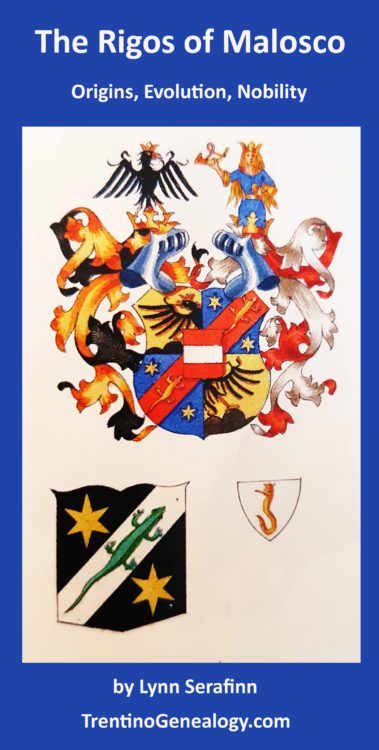
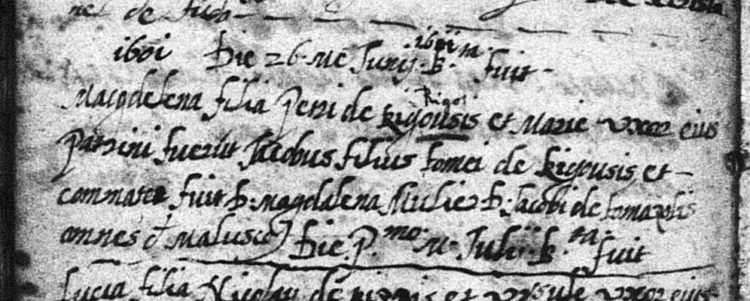
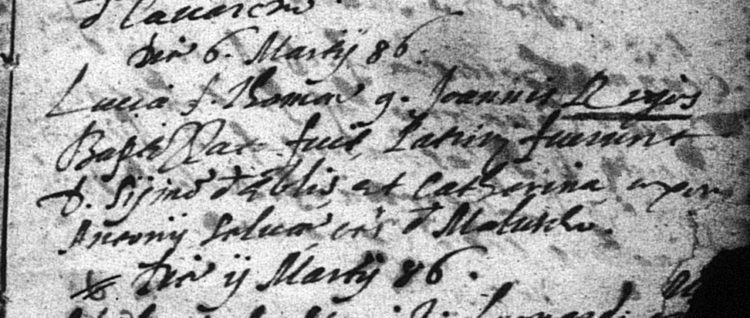
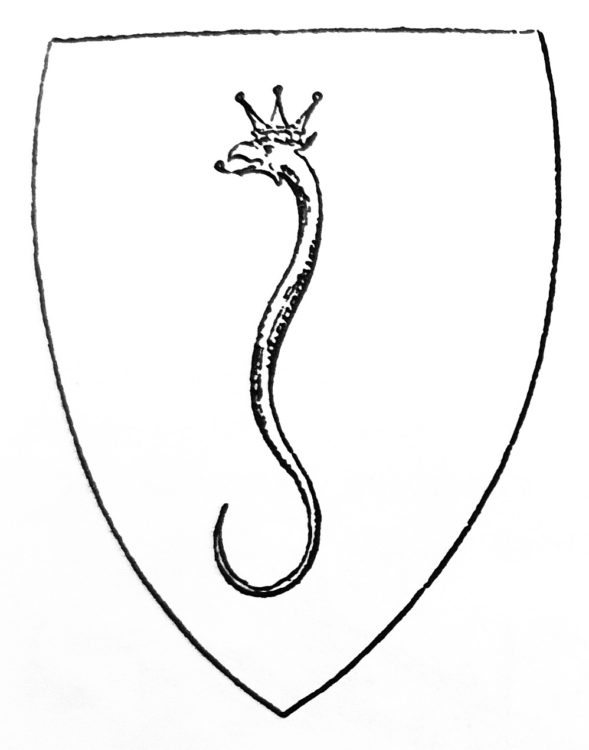
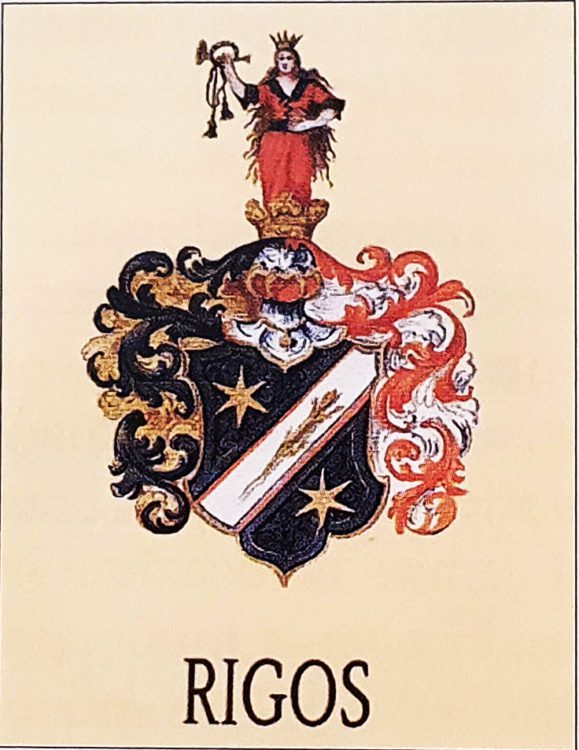
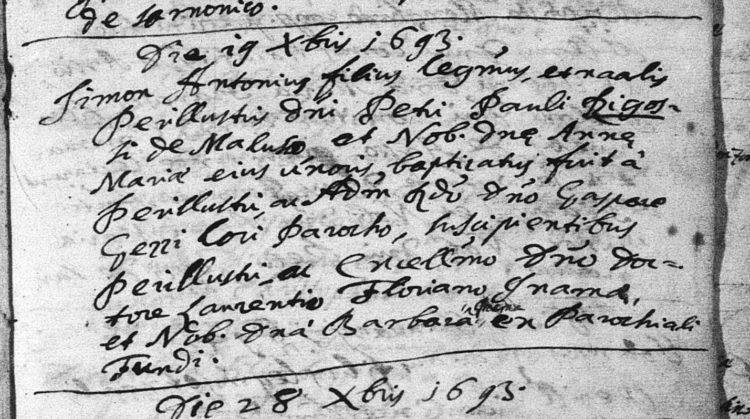
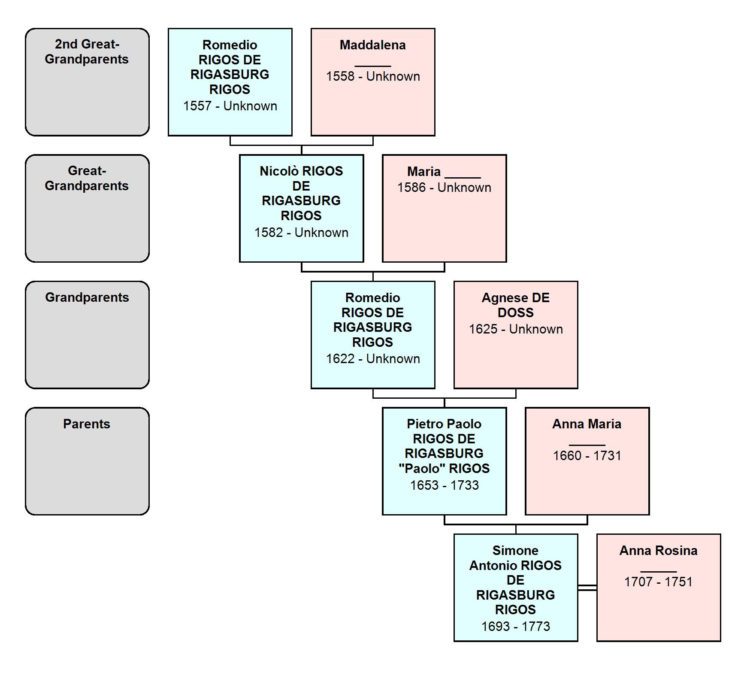
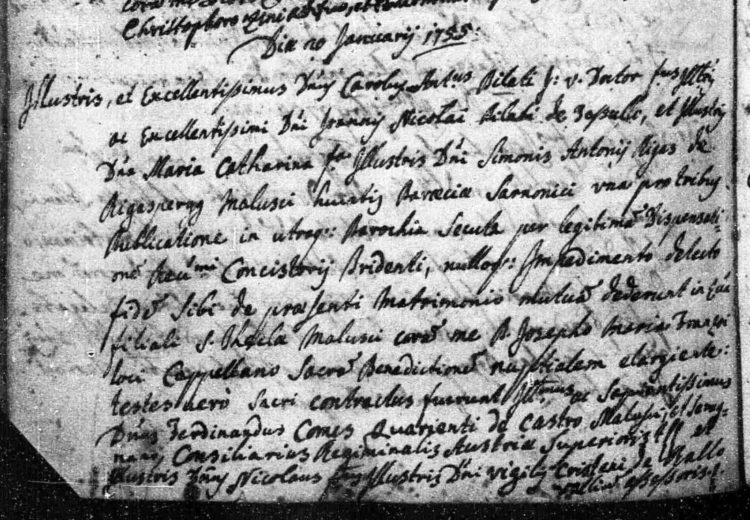
Thank you! I’ve been slowly digging into my father’s maternal lines and you just gave me a huge gift! My paternal great-great grandmother was a Rigos and the last of our line to live in Malosco. My grandmother was able to go visit Malosco and meet some extended family in the late 1990s. One day, I hope to make the trip with my daughter.
Hi Kristen,
Thank you for the kind comments, and also for purchasing the Rigos eBook! I am very happy you enjoyed the article, and that you found the information useful. I haven’t been Malosco yet, but I did go to nearby Cavareno a few years ago, and it is surely a particularly charming and history-rich part of the province. I am sure you will fall in love with your ancestral homeland when you finally have the opportunity to visit. If you need any help researching your Trentino ancestors, drop me a line using the contact form on this website.
Warm wishes,
Lynn Serafinn